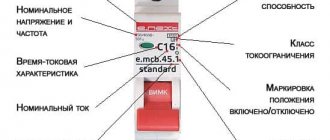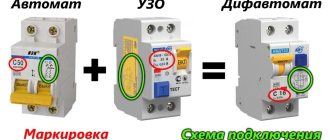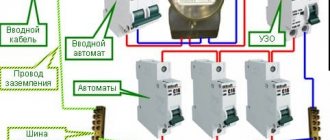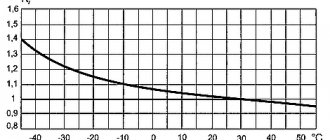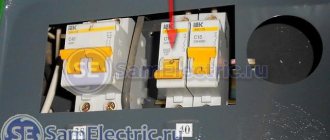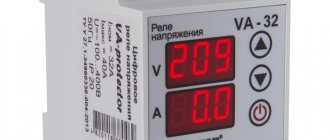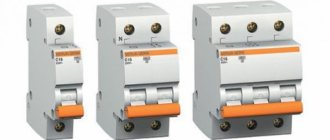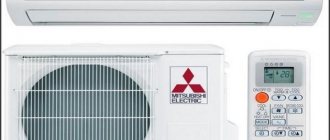To prevent dangerous situations due to faults in electrical wiring or voltage surges in the electrical network, protection devices are installed at the entrance to the apartment - input circuit breakers, differential switches (RCDs). Let's figure out what the difference is between these devices and how to choose a protection compact for your apartment.
Both devices are designed to de-energize the internal network of the apartment in the event of an emergency. In this case, the input circuit breaker is the main means of protection, and the differential switch is an additional one.
Five main differences between RCD and difavtomat
For many people, the words difavtomat and RCD mean nothing.
But the time comes to replace the electrical wiring in the house or the construction of a summer house begins, and experts constantly mention them, the need for protection against electric shock, and offer different options. This is where the home owner needs to make a choice, and the right one. He wants to get reliable protection against electric current for reasonable money, without overpayment and unnecessary equipment. To do this, you need to understand a little about the devices, their purpose, differences, advantages and disadvantages. It will be useful for any novice electrician to understand what the difference is between different RCDs.
What is differential current?
To understand the principle of operation of a difavtomat and an RCD, you should understand the concept. In fact, differential current is not a physical phenomenon or a special type of current, it is a difference in currents that occurs as a result of leakage. The process has negative consequences for the system: it can lead to fires, equipment damage and electric shock to people.
Leaks do not always lead to differential current. If the wiring pierces the body of the device, which is not grounded and insulated, then the RCD will not work. When a person touches the steel body of the device, the circuit closes and a differential current appears.
Purpose of residual current devices
The RCD protects the insulation of electrical wiring and prevents fire. And it protects a person from exposure to electric current when touching parts of devices that have phase voltage.
The RCD is triggered by an imbalance of currents in the phase and neutral wires of the protected electrical network. This happens when an insulation breakdown occurs and an additional leak appears.
Flowing current through unauthorized materials may result in a fire. In buildings with dilapidated electrical wiring, fires from damaged insulation occur quite often.
Another dangerous case is touching live parts of devices that should not be energized under normal conditions. The current begins to flow to the ground through the person, bypassing the neutral wire.
In this case, the circuit breaker will not work, since it requires currents of at least tens of amperes to turn off. Currents starting from 30 mA and above are dangerous to human life. The ability of the residual current device to respond to 10-30 mA is reliable protection against the effects of electricity.
You should know that an RCD does not provide protection against overcurrents; this is the main difference between an RCD and a difavtomat. In a situation where there is only an RCD and a short circuit occurs, the device will not react, and it may also burn out itself. It is not used separately, without a circuit breaker.
If the question is what to choose - an RCD or a difavtomat - you need to understand that together with the RCD you will definitely have to install a circuit breaker in the circuit.
Possible malfunctions and causes of operation
It is obvious that in the event of a malfunction of the RCD or the automatic circuit breaker, as well as the circuit breaker, the lives of users are in danger. Therefore, this issue should be given special attention.
The functionality of the RCD - both stand-alone and part of the circuit breaker - can be checked by pressing the "TEST" button. However, it must be taken into account that such a check is not exhaustive, in other words, complete. An RCD can be triggered by pressing this button, but at the same time be faulty:
- the disconnecting current may exceed the value specified in the passport;
- the response time can be more than 40 ms (if the device is turned off for a long time, the current will have time to cause cardiac fibrillation if a person is injured).
In addition, proper operation of the TEST button is not sufficient proof that the device is connected correctly.
To guarantee the serviceability of the RCD, you need to connect it and generate a test current leak of a threshold value. Such testing should only be carried out by specialists.
The part of the automatic machine that protects against overload does not have a test button. So you can check its serviceability only by installing a short circuit or connecting a device whose power exceeds the permissible one. However, with such a check, a user who does not have special equipment will not be able to understand whether the response time corresponds to the value specified in the passport.
Therefore, an important conclusion should be made: the user cannot conduct an exhaustive check of the protection devices for serviceability, therefore it is extremely important to avoid purchasing counterfeits. Buy RCDs and automatic devices only in large, trustworthy stores. If you had to make a purchase in a small store or at the market, at least ask to see a certificate.
The simplest versions of electronic RCDs (remember that there are also electromechanical ones) may be serviceable, but inoperative. This situation occurs when the neutral wire above the device is broken (or disconnected from the neutral bus, which happens more often). The fact is that the amplifier of such an RCD is volatile and is included in the protected circuit in parallel with other loads.
If the neutral wire breaks, a phase appears on all contacts of the devices, so the electronic RCD will not work, and a person may receive an electric shock
It is clear that when the zero line is disconnected, not a single electrical device, including an amplifier, can work, but at the same time the phase conductor and all current-carrying parts connected to it remain energized. That is, the possibility of electric shock exists, but the electronic RCD will not work and will not disconnect the circuit.
Improved electronic RCDs and automatic devices equipped with a safety mechanism do not have this drawback. They turn off the device if the amplifier is left without power for any reason.
This is the type of device you should buy. The most “advanced” of them can turn on independently after the power supply to the amplifier is restored. Without this function, the difavtomat or RCD will have to be turned on manually every time after the light is turned off.
Now a few words about why RCDs and automatic devices can trigger spontaneously. Most often this is due to several reasons.
Video: how to distinguish a real automatic machine from a fake
Current leakage in the network
Leaks may occur due to:
- old wiring. If the insulation of the wires has cracked over time, and in some places has even completely fallen off (this can often be seen in old houses), then in damp weather the total amount of leaks may well reach the triggering threshold of an RCD or a circuit breaker. Leakage can also occur due to insects or small animals touching uninsulated areas;
- errors during wiring installation. When carrying out repairs, residents, as a rule, lay the wires themselves and, out of ignorance, often violate installation rules. For example, they connect wires using twists, which are also poorly insulated or not insulated at all (when laid hidden). If work is carried out carelessly, the insulation can easily be damaged - current leakage may also periodically occur in such a place;
Connecting wires using cold twist is not allowed by current standards and Electrical Installation Rules (PUE)
- connecting the grounding wire to the neutral wire in the area protected by the RCD or automatic circuit breaker. Usually the jumper is installed in the socket, thus performing grounding. When the load is turned on, the protection device will definitely work: part of the current will flow through the grounding conductor, as a result of which the currents passing through the phase and neutral poles of the RCD will be different.
An RCD can be triggered if the solution used to seal the groove with the laid wire has not yet dried. The moisture contained in it penetrates the wire through the smallest defects in the insulation, thus causing current leakage. You need to wait for the mixture to dry completely and only then turn on the protection devices.
Incorrect connection of the RCD or breaker
In order not to make a mistake when connecting a circuit breaker or RCD, it is important to understand the operating principle of this device. It's simple. The main component is a differential transformer, which contains three coils:
- the first and second are connected respectively to the phase and neutral conductors in such a way that the currents flowing in them have different directions;
- the third is connected directly or through an amplifier to a trip relay.
If the currents on the phase and zero lines are equal, then the electromagnetic fields arising in the corresponding coils of the differential transformer will be equal. Therefore, they will compensate each other. If the currents differ, a residual electromagnetic field will appear, which will induce an EMF in the third coil, and it will turn off the relay.
Hence the main rule: all the current that enters the protected circuit through the phase pole of the RCD / automatic circuit breaker must exit only through its zero pole, and in no case should current be “mixed” with it from the outside.
Those who have a rather vague idea of the RCD device may make the following mistakes:
- The neutral conductor from the protected circuit is connected, bypassing the RCD (differencing circuit breaker), directly to the common neutral bus. It is clear that under such conditions the field from the current flowing through the phase pole will not be compensated (the zero pole is not connected to anything at all), and the device will disconnect the circuit when the load is turned on. This erroneous connection option is called open-phase.
- Often there are several groups of machines in the network, each of which is protected by its own RCD. In this case, an inexperienced installer can connect the “zero” from one group to an adjacent RCD and vice versa. As a result of such an error, both RCDs will trip when the load in any group is turned on.
- A similar situation will arise if a “zero” from any other load is connected to the “zero” of the protected circuit below the RCD - the additional current will provide a difference to which the switch will definitely respond. This error is not uncommon. Specifically, they do the following: install a zero bus, to which “zeros” are connected not only from the protected circuit, but also from neighboring ones; then the conductor from this bus is led to the lower (that is, from the load side) zero contact of the RCD.
- Sometimes one of the poles is connected correctly, and the other - vice versa. As a result, the currents in the differential transformer coils will flow in one direction, and regardless of their ratio, the device will turn off. To avoid confusion, always connect the wires from the power line at the top (fixed contacts) and the load side at the bottom (moving contacts).
In case of some errors, the “TEST” button will work as if nothing had happened; in others, the automatic machine will not respond to its pressing.
There are two conclusions from this:
- do not rely entirely on this mechanism - carefully study the diagram and try to follow it;
- If the connected automatic machine does not work when you press this button, do not rush to throw it away - perhaps it is due to an incorrect connection.
The “TEST” button is intended for an initial check of the functionality of the RCD module or circuit breaker, but if it does not work, this does not mean that the device is faulty - the reason may be an incorrect connection
The leakage current setting of the RCD/breaker is too low
The thing is that an RCD with high sensitivity - the leakage current setting is 30 mA or lower - may cause false operation when too high currents flow through it. If you are faced with such a problem, you can install a low-sensitivity RCD (fire protection) at the input, and then divide the circuit into several groups with lower rated currents and provide each of them with a switch with acceptable sensitivity.
Purpose of the differential machine
The difavtomat is used to protect the electrical network from overload, short circuit and leaks. In addition to the capabilities of an RCD, it performs the functions of a circuit breaker.
It happens that a person connects an extension cord with five or six additional sockets to one outlet, and connects several powerful devices through them. In such circumstances, overheating of the conductors is inevitable.
Or, let’s say, when the electric motor is turned on, the shaft jams, the winding begins to heat up, after some time a breakdown occurs, followed by a short circuit of the wires.
To avoid this, a difavtomat is installed. If the current excess is significant, then the difavtomat will turn off the line within a few seconds, without waiting for the insulation to melt, thereby preventing a fire.
The speed of switching off the automatic circuit breaker depends on how many times the flowing current exceeds the rated current for a given line. If the voltage is exceeded multiple times, up to a short circuit, the electromagnetic release is instantly triggered.
If the current flowing through the line exceeds the rated current by more than 25%, then after about an hour the device will turn off the line and the thermal release will operate.
If the excess is greater, the shutdown will occur much earlier. The response time can be determined from the time-current characteristics given for each device.
How to determine the number of machines?
How many machines can be connected to one RCD? It depends on which machine you choose. The calculation of the quantity depends on the maximum permissible load current and disconnecting amperes.
The PUE states that the RCD/switch ratio is one to one or one to two.
In the standard case, the differential leakage current is 30 mA.
Therefore, one machine, depending on how many amperes it is designed for, can have 6A, 10A or 25A.
To maintain the load on the device, you can set:
- 1 pc – 25A;
- 2 pcs – 10A;
- 4 pcs - at 6A.
Another question often arises: how many sockets can be connected to one device?
Their number directly depends on what household appliances and appliances you will connect to them.
Any number of outlets can be connected to one device, provided that they do not simultaneously include an unacceptable number of electrical appliances.
As a rule, separate machines are installed on the washing machine and oven.
How many amperes should I set the breakers? For a socket group, 16A will be enough; for lighting, 10A options are suitable.
Appearance
General unification has led to the fact that it is very difficult to discern the difference between a difavtomat and an RCD based on the shape and size of the case.
For a single-phase network, the housings of these devices have a size equal to two housings of a single-pole circuit breaker. Each of them has a test button, they are two-pole. Installing an RCD on a DIN rail is no different from installing a difautomatic device.
Externally, differential circuit breakers differ from RCDs:
- according to the inscriptions on the front panel;
- labeling;
- functional diagram.
Usually at the top of the device below the name of the manufacturer is the name of the device. For example, VD and several numbers. VD means differential switch, that is, it is an RCD.
If the abbreviation RCBO is present (an abbreviation for the expression: residual current automatic switch), then it is a difavtomat. In case of damage to the inscription on the front panel, the manufacturer prudently embossed the name of the device on the side of the device.
True, to determine the type of device you will have to remove it from the DIN rail. But this method applies mainly to domestic manufacturers.
Foreign suppliers do not bother about this. Therefore, you have to navigate by markings and diagrams.
Rated current designation
The difference is observed in the designation of the rated current. In the RCD it is written as a number, for example 16 A, which means that the device will operate normally at currents not exceeding 16 amperes. The main characteristic for it is the value of the shutdown current.
For a difavtomat, in addition to the leakage shutdown current, the time-current characteristic is important. It determines at what overload currents and how quickly the device will turn off.
Therefore, before the rated current value there is a letter indicating the limit of exceeding the rated current at which the device will instantly operate. If there is an inscription on the front panel, for example, “C16”, then this means that this is a difavtomat.
Load disconnect switching devices
If the electrical system of an apartment or house is divided into separate circuits, it is recommended to equip each line of the electrical circuit with a separate circuit breaker, and install an RCD at the output.
However, there are many more connection options, so first you need to understand the difference between an RCD and a differential circuit breaker, and then carry out the installation.
Circuit breakers - modified “plugs”
When there was no question of a variety of protective devices, when there was excessive load on the line, “plugs”—the simplest emergency devices—triggered.
Their functionality has been improved and circuit breakers have been created that operate in two cases - when a short circuit occurs and when the load increases close to critical.
The design of the machine is simple: several functional modules are enclosed inside a case made of durable technoplastic. On the outside there is a lever for closing/opening the chain and a mounting groove for “fitting” on the DIN rail (+)
One electrical panel can contain one or several switches, their number depends on the number of circuits serving the apartment or house.
The more separate lines, the easier it is to replace or repair electrical devices. To install one device, you do not need to disconnect the entire network.
Image gallery
Photo from
What happens when adjusting the device
Rated load current of the device
Arc chute for short circuit protection
Bimetal strip for thermal release
A prerequisite for assembling a home electrical network is connecting the machine. Breakers trip quickly when the system is overloaded and due to a short circuit. The only thing they cannot protect against is leakage currents.
RCD – automatic protection devices
It is the RCD that is the device that automatically analyzes the current strength at the input/output and protects against leakage currents. The shape of the body is similar to a circuit breaker, but it works on a different principle.
Inside the housing there is a working device - a core with windings. The magnetic fluxes of the two windings are directed in opposite directions, which creates balance. Thus, the magnetic force in the core is reduced to zero.
As soon as leakage current occurs, a difference in magnetic flux values appears - the output value decreases. As a result of the interaction of the flows, the relay is triggered and breaks the circuit. The response time interval is within 0.2-0.3 seconds. This time is enough to save a human life.
External distinguishing features are the presence of additional terminals (the machine has 1 piece at the top and bottom), a test button, a wider front panel, and different markings (+)
On the case you can see the markings 10 ... 500 mA. This indicates the rated leakage current. For home use, an RCD with a rating of 30 mA is usually chosen.
Devices marked 10 mA can be useful if a separate circuit is routed to a children's room or bathroom where there is a high level of humidity.
The RCD protects against leakage currents, but is useless with increased load on the wires, and also will not help in the event of a short circuit. For this reason, two devices - an RCD and a circuit breaker - are always mounted in pairs.
Only together will they provide a full degree of protection, which must be present in every household electrical system.
Differential automatic – maximum protection
When we talk about how an RCD fundamentally differs from a differential circuit breaker, we mean not a separately installed RCD device, but a pair of “RCD + switch”.
An automatic residual current switch (RCCB), in its essence, is this pair, but combined in one housing.
Thus, it immediately performs three main functions:
- protects against leakage currents;
- prevents line overload;
- Instantly triggered in the event of a short circuit.
Despite its small size, the device operates efficiently and quickly, but under one condition - if it is produced under a reliable, proven brand.
If you do not know the nuances of the device and the symbols placed on the body, a difavtomat can easily be confused with an RCD. One of the clues is the RCBO marking (+)
The technical documentation, which is necessarily attached to the device, lists its characteristics. The designation of the most important indicators is printed on the front side of the case.
In addition to the name marking, the rated load current and leakage current are indicated here. The units of measurement are the same as for simple machines - mA.
At first glance, it may seem that the appearance of a difavtomat completely negates the initially existing “switch + RCD” circuit. However, there are many nuances that govern the choice of one solution or another, and as a result, both installation schemes are relevant and in demand.
Other differences
Already from the purpose of the devices it becomes clear what the difference is between them. The difavtomat is more universal; it includes RCD functions. But beyond the features and appearance, there are other differences.
Price
An important difference is the price. A differential circuit breaker is significantly more expensive than an RCD. Even if the RCD is functionally equal to that of a difavtomat by connecting an additional circuit breaker, the cost of the difavtomat will still be higher.
Dimensions and maintainability
The occupied volume of such a design due to the additional automatic machine will be one and a half times greater than the space for the automatic machine. This is important for small electrical panels.
But the maintainability of devices with equal functionality is better in the RCD+automatic system than in a simple automatic device. In addition, the reason for the shutdown immediately becomes clear - leakage currents or network overload.
Connection
But when installing a differential switch, you don’t have to think about how to install an RCD or connect it before or after the machine. In fact, most experts recommend installing the circuit breaker first, then the differential one.
As for the RCD, there are two options. If the RCD is installed on several groups of consumers, then it comes first, followed by circuit breakers for each group.
If one line is protected by one RCD and one machine, then the machine goes first.
Another point that needs to be taken into account when choosing between a differential circuit breaker and an RCD+ circuit breaker. This is the reliability of the devices. As you know, the simpler the device, the more reliable it is. In this regard, the difavtomat loses.
So, the main difference between a difavtomat and an RCD is their functions, markings, cost, connection method and space taken up in the panel.
What is best to use is decided by each owner independently. The main thing is to connect all devices correctly and provide reliable protection against fire or electric shock.
What to pay attention to when planning
- It is better to install separate protection systems for different electrical wiring circuits. Thus, it is recommended to maintain your own lines for an electric stove, oven, and washing machine. It is also better to divide and equip each room with automatic machines, to power sockets and lighting fixtures separately. This is convenient when you need to de-energize one point, for example, during repairs or connecting some equipment.
- Automatic differential switches are recommended for connecting equipment located in rooms with high humidity. Such equipment includes washing machines, dishwashers, and electric water heaters.
- For repair or replacement, it is more convenient to install separate input circuit breakers and separate differential switches. But combined devices are more compact and easier to assemble in a panel. Think about this question in advance.
On the selection of components, you can always consult with DobroStroy specialists.
Automatic or differential automatic: how to distinguish and what to choose
In electrical networks, there is a constant possibility of some kind of malfunction, damage, or even an emergency. Various types of protective devices used in everyday life help reduce such risks. In this regard, many people are wondering what is better, more reliable and more efficient, an automatic or a differential automatic, how to distinguish and what to choose from existing devices?
It should be remembered that all circuit breakers, differential circuit breakers, and residual current devices serve to increase electrical safety for their intended purpose. They turn off electricity in emergency situations and prevent injury from electric current. These devices can be used in combination or separately, each of them has its own design features.
RCD and differential automatic device: differences in markings
The next question is: how to distinguish an RCD from a difavtomat by one of the signs - the markings applied to its body part.
On the surface of the RCD, the rated current is indicated exclusively by numbers. The Latin letter (B, C, D) in front of them is an integral feature of the RCBO.
Let's look at the above photo again. The body part of the RCD is marked “16A”. It means that the rated current in the circuit in which this device is connected should not exceed 16A. RCBOs designed for a similar rated current are marked “C16”. The letter indicates the characteristics of the built-in releases.
Several ways to distinguish an RCD from a difavtomat in the video:
Electrical faults
The main function of all protective devices is to eliminate possible faults that periodically occur in electrical networks. First of all, they provide protection against short circuits caused by a decrease in the electrical resistance of loads to very low values. The main reason for this condition is the shunting of voltage circuits by metal objects.
Another common malfunction is related to overloading of wires under the influence of powerful modern electrical appliances. As a result, the appearance of large currents leads to increased heating of the wires, especially in low-quality networks. At the same time, overheating and aging of the insulation occurs, with the loss of its dielectric properties. In this regard, another type of fault occurs, known as leakage currents, arising from broken insulation.
Often the situation worsens further due to the use of old aluminum wiring, which is operated under critical conditions of constant increased loads. However, even new systems can malfunction due to poor installation and ineffective protective devices used inappropriately.
Causes of emergencies
- Short circuit - an increase in current strength due to contact of live parts with different potentials. Such contact can occur as a result of a violation of cable insulation, breakdown of electrical appliances, improper connection of equipment, or mechanical damage to the wiring.
- Network congestion - it occurs due to the simultaneous connection of several devices with high power. If the wiring and circuit breakers are not designed for the required amperage, a shutdown occurs.
- The appearance of leakage current - electric current begins to flow not only through the wires, but also along the surfaces in contact with the wiring. This occurs as a result of poor-quality insulation or destruction of cable braiding.
- Installation error - if the electrical wiring is incorrect or defective, an emergency situation can occur at any time.
Mechanism of operation of circuit breakers
The machines are designed to protect against short circuits and overloads. For this purpose, they are equipped with a fast-acting electromagnetic trip coil and a system for extinguishing the electric arc that occurs during a short circuit. Overload in electrical circuits is eliminated using a thermal release with a bimetallic plate operating with a time delay.
The circuit breaker in residential buildings is switched on in the line of one phase wire. Only those currents that pass through it are controlled. The machine does not react at all to leakage currents. Thus, the functions of the circuit breaker are significantly limited. Additional protection is provided by a residual current device, which is connected in series with the circuit breaker.
Installation and connection
circuit breaker and RCD are manufactured according to the same scheme. A special latch on the device body allows it to be firmly secured to a designated DIN rail inside the distribution panel.
No additional tools or devices are required. The wires are connected using a standard screw clamp. The bare wire is inserted between the screw head and the locking washer (for this purpose, there are slots in the plastic body of the device), after which the screw is tightened with a regular screwdriver.
{SOURCE}
Differential machine device
The design of a differential circuit breaker is much more complex than that of a conventional circuit breaker or RCD. Its functions include eliminating all types of faults, including current leakage resulting from damaged insulation. The protection of the RCD built into the automatic circuit breaker is carried out using an electromagnetic and thermal release. All structural elements are enclosed in one module and located in a common housing.
Devices in a modern modular design are mounted on a special DIN rail. This allows you to significantly reduce the space required for their installation in the electrical panel. This is one of the main differences between a difavtomat and a conventional circuit breaker installed together with a residual current device.
comparison table
The main features and differences of the devices are shown in the table:
| Criterion | Difavtomat | RCD |
| Purpose | Reacts to leakage and protects wiring. Combines the functions of an RCD and an automatic device. | Reacts exclusively to leakage. Always installed with a machine gun. |
| Dimensions | A single-phase device occupies 2 modules in the panel. | The RCD is installed with the machine, so it takes up 3-4 modules. |
| Appearance | The trip class is indicated before the rating. | The trigger class is not specified. |
Which protective device to choose
The differences between circuit breakers and differential circuit breakers must be taken into account when designing protective systems and electrical networks in general. Thus, it is possible to avoid a shortage of free space in existing electrical panels. The choice of a specific device is made in accordance with the tasks that will have to be solved during further operation.
Despite solving the same problems, the action of each device differs under the same conditions. For example, situations often arise when the total power of several devices can become greater than the rated protection value, which leads to a current overload. In this case, you will need to replace the installed automatic machine with a more powerful model. If an RCD is used, then it is quite possible to get by by replacing a cheaper circuit breaker.
A differential circuit breaker is best suited for protecting a separate electrical appliance connected to a dedicated line. The choice of device is carried out in accordance with the technical characteristics of the protected consumer.
When deciding whether to choose an automatic or differential automatic, you should take into account possible difficulties during installation work. There are no significant differences in the fastening system itself. They appear when connecting wires, since for a circuit breaker, in addition to phase and zero, additional jumpers will be required to make a serial connection to the phase wire together with the RCD. In certain situations, the assembly diagram can become significantly more complicated.
The high-quality, reliable and durable operation of each device is of great importance. These indicators are influenced by design features, number of parts and elements. In this regard, the differential machine is more complex and requires more settings for the operation of all parts and assemblies. The same goes for replacement and repair. Each device can fail and if repair is impossible, it is replaced. Purchasing a new differential circuit breaker is considered a more expensive process compared to replacing a conventional switch or RCD.
Criteria for selecting electrical protection devices
Let's try to figure out what is better for the home - an RCD or a differential circuit breaker, and consider various installation situations. Most often, the choice is influenced by factors such as the position of the device in the electrical panel, the nuances of connecting to power lines, and the possibility of maintenance or replacement.
Features of installation in an electrical panel
An electrical panel is a metal box, inside of which protection devices and an electric meter are usually located. The working panel to which the devices are attached is limited in size.
If the electrical network is improved and additional modules are installed, then there is a shortage of free spaces on the DIN rails. In this case, difautomats find themselves in an advantageous position.
Layout of “automatic + RCD” pairs on the DIN rail (top row) and automatic circuit breakers (bottom row). Obviously, lower units take up less space. The difference will increase if the protection is designed for a larger number of circuits
Modern equipment of apartments with electricity is focused on increasing the number of circuits. This is due to the emergence of a large number of powerful equipment, and to the division of the network into many lines. In such a situation, in the absence of additional space, the only reasonable solution is to connect difavtomats.
When selecting devices, pay attention to devices that occupy one module-space. Such models have already appeared on sale, but their cost is slightly higher than traditional ones.
Difficulty connecting wires
The main difference in connection between the two indicated options is the number of wires. Two separate devices have more terminals in total - 6 pieces, while the difavtomat has only four. The connection diagram is also different.
Comparative diagram of installation and connection of a protective pair and a difautomatic device. The result of operation in an emergency situation and the reliability of the devices are the same, but the order of connecting the wires is different
The diagram clearly shows the wiring connections.
When connecting a pair of AB + RCD, the situation is as follows:
- the phase wire is connected to terminal AB;
- the output of the machine and the L-terminal of the RCD are connected by a jumper;
- the output of the RCD phase is sent to electrical installations;
- the neutral wire is connected only to the RCD - at the input with the N-terminal, at the output - it is sent to electrical installations.
With a difavtomat, the connection is much simpler. Jumpers are not needed, just connect phase and neutral to the corresponding terminals, and send them from the outputs to the load.
What does this give to the installer? Facilitates the connection process, reduces the number of wires, and, accordingly, guarantees more order in the electrical panel.
How is triggering diagnosed?
If we consider devices from the middle price segment, then the tandem “automatic device + RCD” has advantages. Suppose there was an emergency power outage on one of the circuits.
It is difficult to immediately determine the reason for the protection to operate, since it could be a leakage current, a short circuit, or a total load that the wires could not cope with.
When an RCD or circuit breaker is triggered, you can immediately see where to look for the cause. In the first case, there is an insulation problem, in the second, there is an increased load or a short circuit. The latter can be determined by additional characteristics
If the automatic machine responded to a network failure, then it will take longer to look for the cause. It is necessary to check all versions, and this will take more time and effort.
To simplify diagnostics, it is recommended to purchase devices from a more expensive price segment - they are equipped with additional indications indicating a possible problem.
Which devices are cheaper to buy and repair?
There are situations where the choice is based on cost. For example, there is a budget that cannot be exceeded. In this case, the total cost of all connected protection devices plays a decisive role.
At first glance, a larger number of devices are characterized by a higher price. In fact, everything is different: a universal automatic machine costs a tidy sum, but a set of other devices turns out to be economical.
If you monitor the price tags of all the designated machines, it turns out that one automatic machine is almost twice as expensive as the “AV + RCD” set
It should be remembered that the number of lines is usually 3 or more, so the difference between purchases increases. If for one circuit the purchase of RCBOs is only 1 thousand rubles more expensive, then for five circuits the difference in amounts grows to 5 thousand rubles.
Thus, both automatic devices and RCD units with circuit breakers have their advantages and disadvantages. If RCBOs win in compactness and ease of connection, then they clearly lose in diagnostics and cost accounting.
What is better to install in the panel: “difavtomat” or RCD?
Electrical wiring in a residential building is the most important element in providing power to devices and equipment. But you can’t do without protection in the electrical network. We will tell you the differences between an RCD and a differential circuit breaker and where they are best used.
In any case, it is impossible to do without protective elements of the electrical network in the apartment and in the country. These devices not only prevent serious consequences in the event of a short circuit and protect against exceeding permissible loads in the network, but also prevent current leakage. In most cases, circuit breakers, or “circuit breakers,” are used to protect devices from the consequences of a short circuit, while residual current devices (RCDs) are used to protect against possible leaks.
At the same time, both are well solved by combined devices, which have a mathematical name - differential circuit breakers, or “differential circuit breakers”. These are very convenient devices that combine two functions in one housing: an RCD and a circuit breaker.
Which is better - RCD and VA separately or difavtomat
This question, without a doubt, arises before everyone who has to connect electricity in a house or apartment, since the use of protection devices is mandatory (requirements of the PUE). Each option has both advantages and disadvantages. First, let’s evaluate the strengths of difavtomats:
- Size. In the most common case, when the network is single-phase, and a two-pole RCD is supposed to be used, the difavtomat will occupy 2 modules on the DIN rail, while the “RCD + VA” pair will take as many as 3 (2 will be occupied by the RCD). If power consumers are divided into several groups, which is done very often, then the VA and RCD, accordingly, will also need several, which means that quite a lot of space will be saved when replacing them with a difavtomat. This factor is especially relevant for those users who have to deal with small-sized electrical panels.
Each pair of RCD+AV occupies one module more than a difavtomat
- Number of connections and ease of installation. Connecting one device instead of two, although slightly, is still easier. If an inexperienced installer does this, then the likelihood of an error will be lower. But most importantly, the number of connections will be reduced, which will have a positive effect on the efficiency and reliability of the system.
Here are the arguments given in favor of using separate devices:
- Price. Most manufacturers, known for the high quality of their products, cost more than separate RCDs and VAs with the same parameters. It is also necessary to take into account the cost of replacing the device if it fails. If, for example, the RCD breaks down, then only it will have to be changed. If any module of the automatic machine fails, then the entire device will have to be replaced, even if the second module is operational. Let us repeat that all of the above is a rule only for branded products - this price ratio is not always observed among middle- and budget-class manufacturers. For example, a difavtomat AVDT32 for 16A/30mA from IEK costs 600 rubles, while an RCD of the VD1-63 brand with the same parameters and an automatic switch VA47-29 for 16 A from the same manufacturer cost 600 and 35 rubles, respectively. But even in this case, although the difference in the cost of the difavtomat and the RCD + VA pair is practically unnoticeable, the advantage of free-standing devices is obvious: if the overload and short-circuit protection module in the difavtomat fails, then replacing the device will cost 600 rubles, while the breakdown of a free-standing VA will require a cost of only 35 rubles.
- Ease of use. A user who has separate RCDs and VAs installed will be able to easily guess what is going on if an emergency occurs. If the RCD has tripped, then there is a current leak; if it is VA, there is an overload or short circuit. For the owner of a difavtomat, the problem will not be so obvious, since it is not clear which module was triggered. Of course, all this applies only to automatic devices in the simplest design and is not relevant for more modern devices equipped with an RCD activation indicator (special flags). But not all manufacturers have mastered the production of the latter, and even famous brands do not have such devices in every series.
For some automatic devices, the reason for the trip is determined by the position of the “Return” button: if it is pressed, then the RCD has tripped, if not, then a short circuit or overload has occurred
So, in each individual case, either one or the other option may be preferable. It all depends on the layout of the protected network (in particular, on the number of groups), the size of the electrical panel and the specific device models that the user decided to choose.
As for operating parameters and reliability, in this respect RCDs and difavtomats are identical. Current leakage protection modules in difavtomats are also electronic and electromechanical, and in the same way, the difavtomat must be selected according to the type of leakage current - only for alternating current (type AC), for alternating and pulsating direct (type A) or for all types of current, including straightened (type B).
Video: RCD or differential circuit breaker
What to install: difavtomat or RCD
Below we will briefly describe what both devices are, and also find out whether an RCD or a difavtomat, which one to choose. For now, it’s better to dwell on the main parameters of choice, which often act as limitations. This includes the price of the device, the inconvenience of connection and, of course, the size of the panel where you will install the device.
But the main criterion is still the purpose: why this or that device is installed. In particular, to ensure the safety of one consumer and one line, feel free to take a difavtomat.
At the same time, you need to remember that you will need to provide quite a lot of space in the shield for additional protection. As you know, for an RCD it is also necessary to install a circuit breaker, because it does not have built-in overcurrent protection. It turns out that the machine requires one module-place, and the RCD requires three (the module itself is twice as thick). The same applies to connecting outgoing lines, the number of which also depends on the number of groups of sockets.
Currently, you can already find on sale single-module difautomatic devices, which in terms of their functions are identical to conventional RCBOs: they have both an RCD and an automatic circuit breaker.
But RCBOs have a peculiarity when connecting, because involves the use of additional and very expensive tools such as press pliers, strippers and other tools that will reduce installation time.
What is the difference
At first glance, both devices solve the same problem. However, in reality there is a certain difference. The difavtomat differs in the following parameters:
- Automatic devices are more expensive than RCDs.
- The use of a protective pair will accurately indicate the reasons for the emergency operation, while automatic devices will not cope with this task.
- The differential automatic has a more compact size. It takes up 1.5 times less space than an RCD with a machine gun.
- Connecting a difavtomat is more profitable, since there is no need to choose which device needs to be turned on first.
How to connect an RCD and a difavtomat
The assembly of these devices is carried out in a standard way: the phase wire is connected to the circuit breaker, and then leaves the machine and is connected to the upper “phase” terminal of the RCD. The neutral wire is connected directly to the upper “zero” terminal of the RCD. Then the phase and zero move from the lower terminals of the RCD to the consumer.
The connection diagram for the difavtomat is a little simpler: the phase and neutral wires are connected directly to the upper terminals of the device. From the lower terminals the power goes to the consumer.
Replacement and maintainability
It is worth noting that breakdowns can occur on almost any security device. If you cannot eliminate it immediately, the protection device may fail. Therefore, you will have to buy a new device. The cost of a differential circuit breaker is much higher than that of residual current devices and a simple circuit breaker. And if you install an RCD and a circuit breaker, then in the event of a breakdown one of the devices will be intact and will not need to be replaced. And this will significantly reduce repair costs.
If any protection device (for example, an automatic differential switch) breaks down, then all consumers that are powered through it must be turned off. If the RCD is faulty, then it is allowed to bypass its circuits and supply power only through the circuit breaker. As you understand, if there is a malfunction in the differential machine, then you won’t be able to “cheat” this way. It will be necessary to replace it with a new one or install a regular circuit breaker for a certain time.
Features of application
As you know, it is necessary to install a protective device in an electrical circuit precisely for the purpose of protection: as a result of a power surge or other emergency situations, it turns off the power using special technologies. As a result of such an operation, the technician will have to find the cause of the shutdown, which may include either a short circuit or a current leak. In the case of using RCBOs, such reasons may not be immediately detected.
But when using the “automatic device + RCD” combination, you will immediately see: if the RCD turns off, the fault lies in a current leak, but if the circuit breaker trips, then the reason is a short circuit or line overload.
Why do devices turn off?
The differential circuit breaker and the RCD can be turned off in different ways. The RCD turns off when a current leak is detected in the electrical network. If the circuit breaker that provides RCD protection turns off, this indicates a short circuit or excessive load. If the differential machine is turned off, you can determine the cause using a specialized mechanical indicator, which is equipped with most of these devices. The indicator is activated only when a leak occurs.
What is an RCD
The RCD works as a human protector from electric shock and as a preventive mechanism to prevent accidental fire of wiring cables and connected cords of electrical appliances.
The functional idea of the device under consideration is based on the laws of electrical engineering, which postulate the equality of incoming and outgoing current in closed electrical circuits with active loads.
This means that the current flowing through the phase wire must be equal to the current flowing through the neutral wire - for single-phase current circuits with a two-wire wiring, and that the current in the neutral wire must be equal to the sum of the currents that flow in the phases for a three-phase four-wire circuit.
When in such a circuit, due to accidental human contact with non-insulated parts of the conductive elements of the circuit or when the exposed part of the wiring (due to damage) comes into contact with other conductive objects forming a new electrical circuit, a so-called current leakage occurs - the equality of the incoming and outgoing currents is violated .
This violation can be recorded and used as a command to shut down the entire electrical circuit. Based on this process, the RCD was designed. And the “leakage” current in the framework of electrical engineering began to be called differential current. An RCD can detect very small leakage currents and perform the functions of a switch mechanism.
When choosing an RCD, you need to remember that it does not provide internal protection against overcurrents; the RCD protects and reacts only to leakage current. Therefore, a circuit breaker must be installed in series with the residual current device. The rated current of the machine must be less than or equal to the rated current of the RCD.
The need for power grid protection
A home electrical system is a complex branched network consisting of many circuits - lighting, sockets, separate power and low-current circuits. It includes all electrical installations that have to be used daily. The simplest among them are sockets and switches.
During the operation of household electrical appliances, unforeseen situations arise, which result in the failure of individual circuits, devices, as well as accidents.
The causes of trouble are the following:
- excessive load on power lines;
- leakage currents;
- short circuits.
You can encounter overload if you use new powerful equipment in an apartment with old wiring. The cable cannot withstand the total load, overheats, melts and fails.
An excellent example of the thoughtless use of a Chinese-made extension cord without a fuse, coupled with tees. Simultaneous use of several devices on the same power line can cause melting of contacts and insulation, as well as fire
The danger of leakage currents appears when the insulation of electrical cables and devices becomes unusable, or the equipment is installed incorrectly or grounded.
If the current rises above 1.5 mA, the effects of electricity become noticeable, and more than 2 mA causes convulsions.
A short circuit that occurs due to an unintentional connection between zero and phase also leads to irreparable consequences. The result of the formation of an electric arc is the ignition of a separate section of wiring, and often surrounding objects.
To protect equipment, property, and most importantly, the life and health of residents, emergency shutdown devices are used. Without them, a modern electrical wiring system in an apartment or private house is considered inferior and dangerous.
How to distinguish an RCD from a difavtomat visually
Everything here is quite simple, although the two devices are very similar to each other. First of all, on the front side of the RCD you can see a powerful switch, an indicator and a “Test” button. Secondly, on the RCD on the body the current marking is indicated in large numbers, for example, 16A.
If at the beginning of the inscription there are the Latin letters B, C or D, and then there is a number, then this is a differential machine. For example, the current strength 16 is preceded by the letter “C”, which means the type of characteristic of the electromagnetic and thermal releases.
The difference in appearance between an RCD and a differential circuit breaker
Determine which device is in front of you - an RCD or a differential device. automatic – quite easy even visually. Despite the external similarity (switch lever, the presence of a “Test” button, the same body part with a diagram printed on it, as well as numbers and letters), it is enough to look closely to see that the designations on these devices are different. We'll talk about this below. It’s even easier to determine whether the RCD or the automatic circuit breaker is in front of you by the location of the “Test” button and switch. For RCBOs, the lever is located on the left, the button is on the right, but for RCDs it is the other way around. This can be clearly seen in the above photograph.
When the RCD does not protect
The RCD will not react when a person or animal comes under voltage, but no ground fault current will occur. This case is possible when touching simultaneously the phase and neutral conductors, which are under the control of an RCD, or when completely insulated with the floor. RCD protection in such cases is completely absent. An RCD cannot distinguish the electric current passing through the body of a person or animal from the current flowing in the load element. In such cases, safety can be ensured by mechanical protection measures (full insulation, dielectric casings, etc.) or complete de-energization of the electrical device before its technical inspection.
Therefore, the RCD is always connected in series with the machine. These two devices work in pairs: one protects against leaks, the other against overloads and short circuits.
How they work in different situations
And now about the difference between an RCD and an automatic machine from the point of view of circuit design. The circuit for monitoring leakage currents of a differential circuit breaker and a residual current device can be implemented on various element bases:
- Electromechanical relay design that does not require additional power supplies for normal system operation.
- Using microprocessor or electronic technologies, which necessarily require a power supply capable of delivering a stable voltage.
If the wires connecting to the devices are in good condition, then they work almost the same. But if malfunctions appear in the circuit, for example, the contact of one wire (“zero”) breaks, then you can immediately see the positive qualities of models built using a relay circuit. It should also be noted that they are more reliable and work better in outdated two-wire circuits.
Markings on the body
Now let's look at the differential. automatic and RCD. What is the difference between these devices. The differential circuit breaker and the residual current device have identical housings, therefore, they have the same appearance, there is a lever for manual activation, a button labeled “Test”, and the terminal blocks for connecting the wires are also the same. But they can be distinguished by the inscriptions and diagrams that are present on the front side. The labels of the electrical appliance must indicate which load values are rated.
It is also necessary to indicate what leakage current can be monitored, the voltage in the electrical wiring, as well as the connection diagram of the internal components of the device. It is imperative to show the differential current circuit transformer that is being controlled.
The residual current device does not have current protection, so it is not shown in the diagram. As for the differential machine, it is included in its design, so it should be shown on the body. What is the difference between an RCD and an automatic machine? You now know; all that remains is to choose the right one for what you need.
As for devices produced by domestic industry, they are marked in such a way that the buyer can independently navigate them. Directly on the body, in the most visible place, it is indicated that the device is a differential. automatically. In the case of a residual current device, this marking is located on the rear wall.
"VD" means that it is a differential switch. It is worth noting that from a technical point of view this is the correct designation option. This device only responds to leakage current, but does not protect against overcurrent or short circuit. These letters are usually used to mark residual current devices. There is also the abbreviation “AVDT”. It indicates that the design has a circuit breaker. Strictly speaking, this is a differential machine. Therefore, if you are deciding what to choose - an RCD or an automatic device, it is better to install a differential one. Although it is more expensive, it is more modern and efficient.



